If you live in, or have visited, the eastern United States, then you may have heard of cottonmouth and copperhead snakes. Both are venomous, and they occupy many of the same habitats. But are there cottonmouth and copperhead hybrids?
Hybrids abound in the natural world, though not all of them can produce offspring. From the mule to the liger, hybrid creatures fascinate people. Hybrid snakes exist, and there just might be one lurking in the forests of the eastern United States. For years, reports of cottonmouth and copperhead hybrids have abounded, but is there any truth to the stories?
Here, we’ll find out just what makes a cottonmouth what it is and a copperhead what it is. Then, we’ll look at the biggest differences between the two species. After that, we’ll answer the question of whether or not cottonmouth and copperhead hybrids exist and, if so, where they might live. Finally, we’ll go over how you can tell if a snake you saw is a hybrid.
Background: Cottonmouth (Agkistrodon piscivorus)
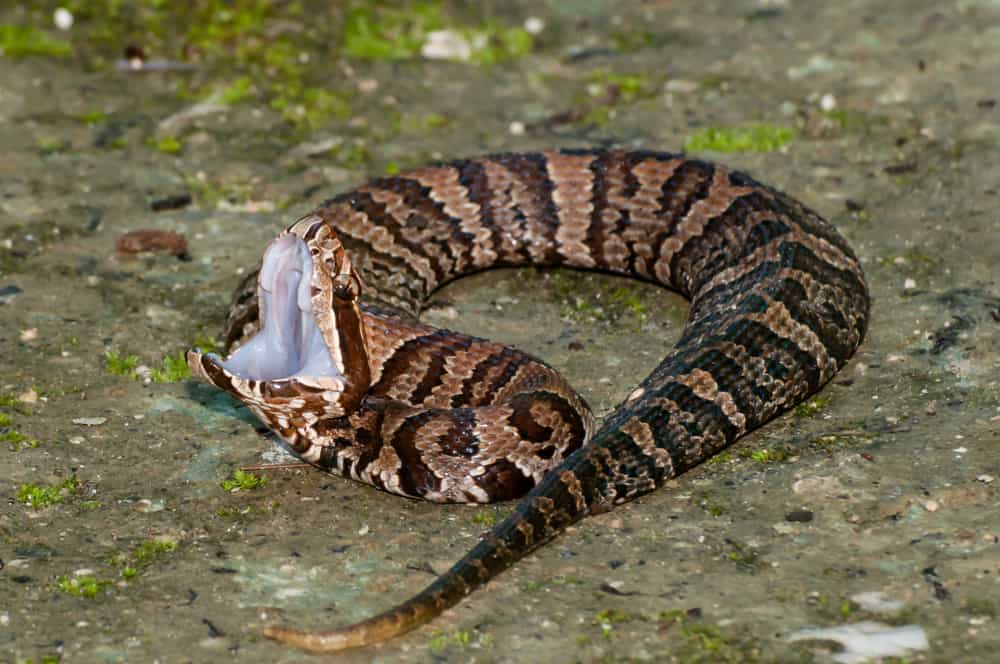
Cottonmouths are also known as water moccasins.
©Jay Ondreicka/Shutterstock.com
Cottonmouths are one of the most famous venomous snakes in the southeastern United States. They live throughout the coastal southeast (including Florida) and as far west as central Texas. It’s easy to recognize cottonmouths by their snow-white mouth interiors, which they readily display when threatened. They typically grow up to four and a half feet long and have heavy bodies. Cottonmouths have a base color that is light brown to dark brown with pixelated bands that sometimes look similar to copperhead markings.
Cottonmouths eat a diet that consists almost entirely of fish and amphibians, though they won’t pass up a small mammal or reptile if given the opportunity. They’ve also been known to eat baby alligators, birds, and even small turtles. They’re capable hunters both in the water and on the land.
Background: Copperhead (Agkistrodon contortrix)
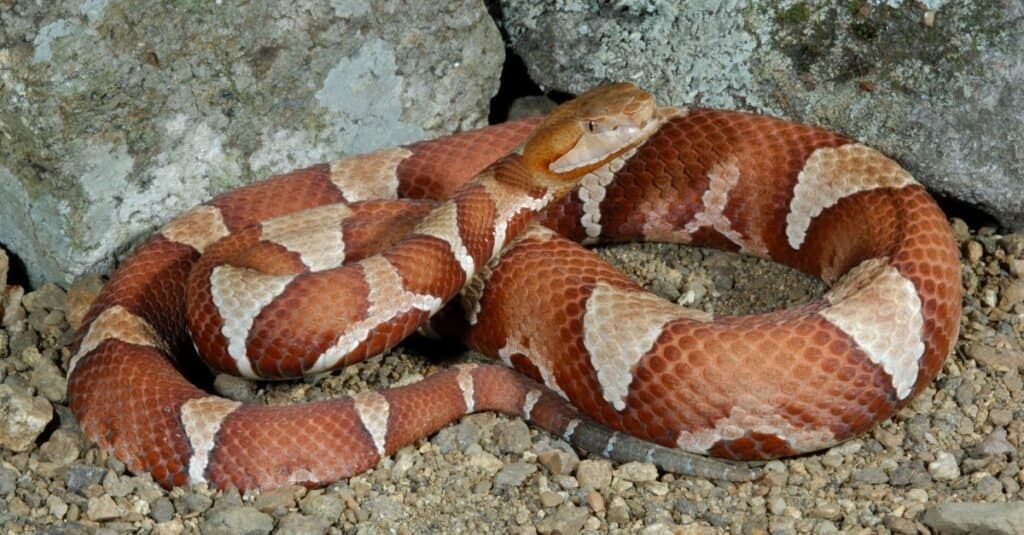
Copperheads occupy many of the same areas as cottonmouths, but don’t extend beyond the Florida panhandle.
©Breck P. Kent/Shutterstock.com
Copperheads are very similar to cottonmouths in appearance, location, and behavior. But instead of pixelated bands, they have crisp-edged crossbands that often look like chocolate kisses or hourglasses.
Like cottonmouths, copperheads are venomous. They’re widespread, and their markings give them excellent camouflage. Because copperheads lie still on the leaf-covered forest floor, they get stepped on. A lot. When someone steps on a copperhead, it bites. As a result, they’re responsible for nearly half the venomous snakebites annually. However, copperhead venom is not as dangerous as most rattlesnake venom, and it rarely proves fatal. Bites still require immediate medical intervention, but prognoses are generally very good.
What’s the Difference Between Copperheads and Cottonmouths?
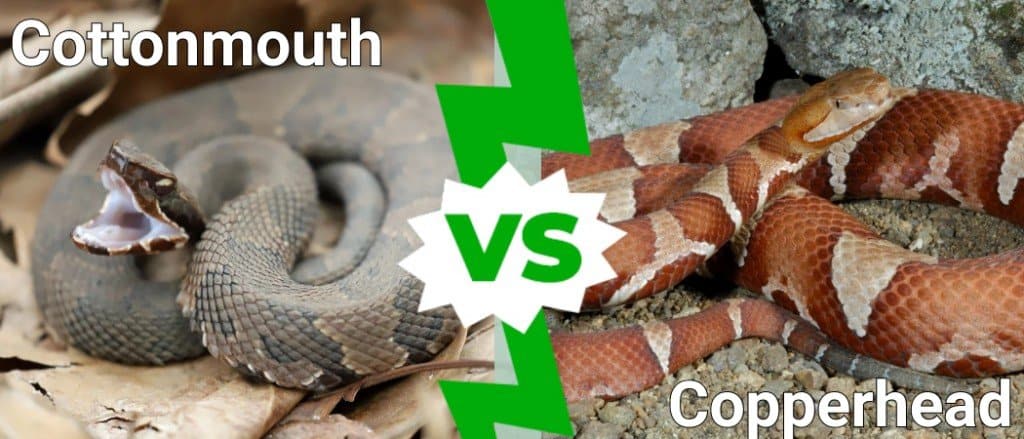
The biggest difference between cottonmouths and copperheads comes from their appearance. When seen side by side, it’s easy to recognize the differences in color and patterns. But if you saw one of these snakes in the bush, it might be harder to determine which is which.
Another difference comes from each species’ behavior. Only cottonmouths coil up and display the white interiors of their mouths. Also, cottonmouths are much more likely to be seen in the water and rarely stray too far from permanent water sources, while copperheads prefer dry land. Copperheads are slightly smaller than cottonmouths, with thinner bodies.
As babies, copperhead and cottonmouth snakes have bright greenish yellow tail tips. They use these to attract prey. Furthermore, copperheads are more likely to live near areas of human habitation than cottonmouths. One of the biggest threats to copperheads is vehicles; the snakes die when crossing roads and highways.
Can Copperheads Breed with Cottonmouths?
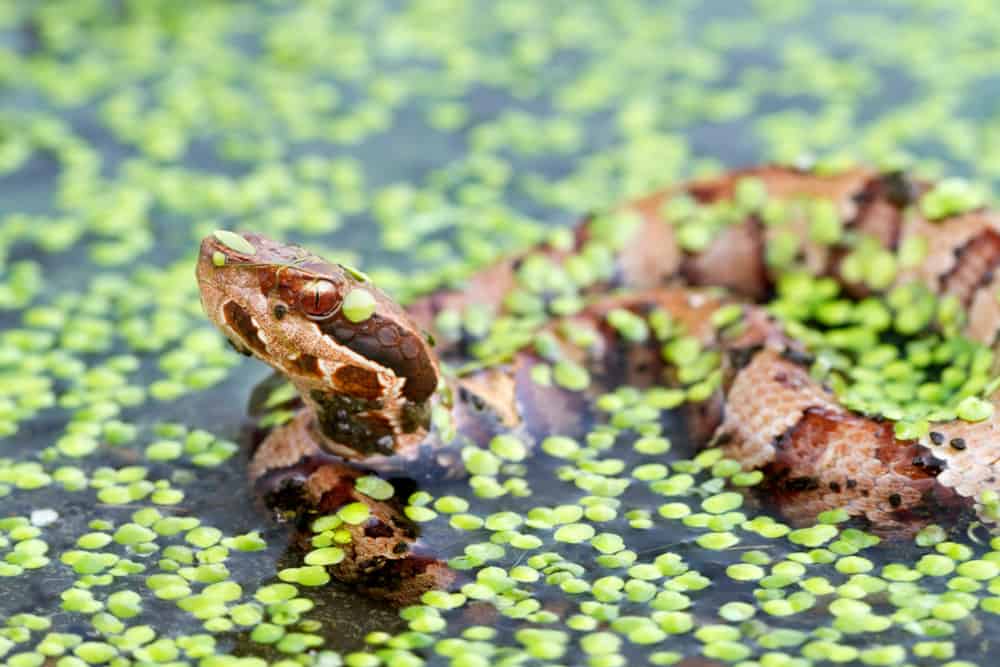
Cottonmouth and copperhead hybrids have only been created in captivity.
©Mark_Kostich/Shutterstock.com
Cottonmouth and copperhead hybrids have only been confirmed in captivity. No wild cottonmouth-copperhead hybrids have ever been verified. Because the two species are closely related, interbreeding is possible. But, each species has its own set of behaviors and mating rituals, which means that hybridization in the wild is highly unlikely.
To date, no wild specimens have ever been confirmed. However, numerous breeders have successfully hybridized cottonmouths with copperheads.
What are Copperhead/Cottonmouth Hybrids Called?
Accounts vary, but most breeders call their cottonmouth-copperhead hybrids either cottonheads or coppermouths. Alternatively, they’re known simply as cottonmouth and copperhead hybrids. Due to the paucity of living specimens, it’s unknown how the hybridization affects things like venom potency, lifespan, and reproductive potential.
How Can You Tell if a Snake is a Hybrid?
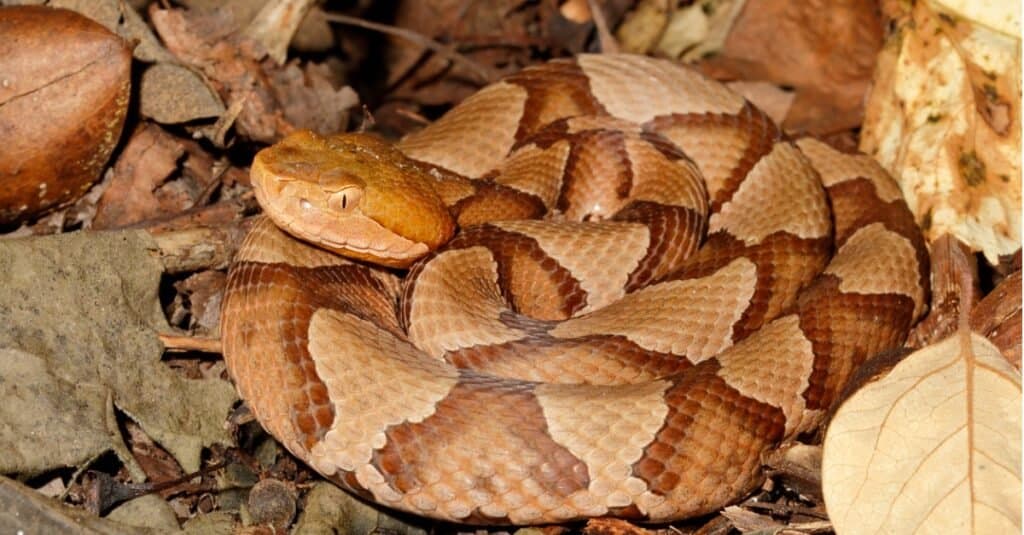
Hybrid snakes get half of their genetic material from each parent.
©iStock.com/David Kenny
Cottonmouth and copperhead hybrids generally have scale patterns somewhere in between the two species. They may have the hourglass shape of the copperhead combined with the chevron shapes of the cottonmouth’s pattern. Or, they may simply look like one or the other species.
The only real way to tell if a strange-looking snake is a cottonmouth-copperhead hybrid is to test its DNA.
Can Black Rat Snakes Breed with Copperheads?
Just as there are stories of cottonmouths breeding with copperheads, there are tales of copperheads breeding with an entirely different snake, the black rat snake. Black rat snakes (Pantherophis obsoletus) are non-venomous snakes that also live in the southeastern United States. Oftentimes, they share dens with copperheads during the cold winter months. But, can the two produce super venomous, hybrid offspring?
Unlike the cottonmouth and copperhead hybrids, copperhead and black rat snakes cannot breed. Black rat snakes belong to an entirely different group than copperheads, which means they can’t produce offspring. So, even if these two species did mate, they wouldn’t be capable of reproducing.
Are There Hybrid Snakes in the U.S.?
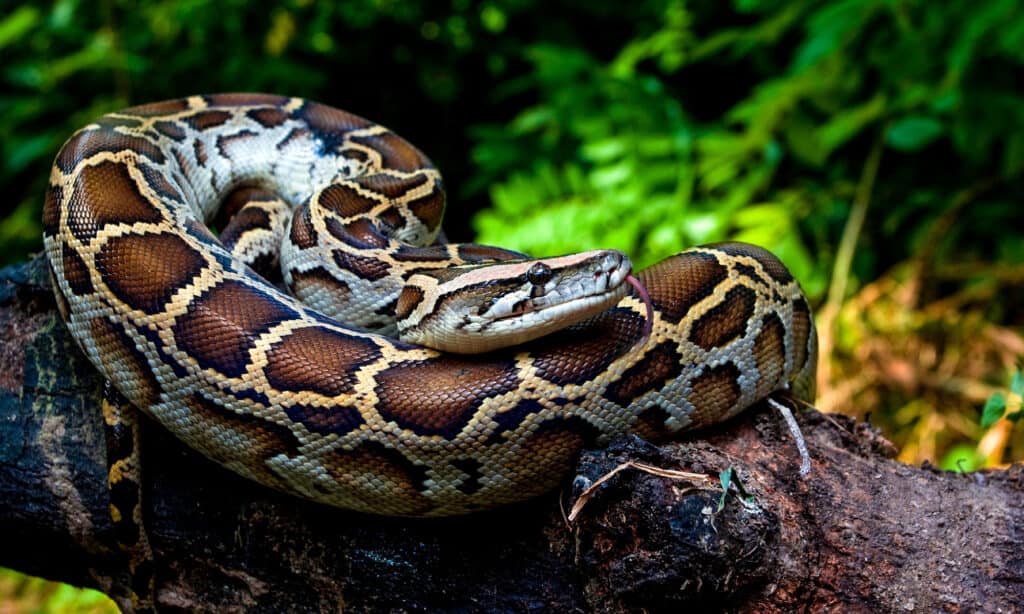
Burmese
pythons have been found to have mated with Indian rock pythons in the Florida Everglades, producing a hybrid snake that’s better suited to thrive than its non-hybrid cousins.
©dwi putra stock/Shutterstock.com
One U.S. state where it’s been proven that hybrid snakes exist is the state of Florida. Florida has been dealing with certain invasive snake species like Burmese pythons for decades. Burmese pythons pose a serious threat to wildlife in the Florida Everglades, as they are apex predators that have no natural predators there. They cover an area of 1,000 square miles in the Everglades with an estimated population of 100,000 snakes.
Certain captured pythons that were studied were found to be hybrids–they contained DNA of both Burmese pythons and Indian rock pythons, a smaller python species that has a population in that region. The study concluded that about 3% of the 400 wild Burmese pythons were hybrids. They also believe this hybridization gives the invasive pythons an edge over their non-hybridized cousins. They’re better suited to thrive in a wide range of habitats than non-hybridized Burmese pythons, making them even more of a threat to Florida’s biodiversity.
The photo featured at the top of this post is © Kristian Bell/Shutterstock.com
Discover the "Monster" Snake 5X Bigger than an Anaconda
Every day A-Z Animals sends out some of the most incredible facts in the world from our free newsletter. Want to discover the 10 most beautiful snakes in the world, a "snake island" where you're never more than 3 feet from danger, or a "monster" snake 5X larger than an anaconda? Then sign up right now and you'll start receiving our daily newsletter absolutely free.
Thank you for reading! Have some feedback for us? Contact the AZ Animals editorial team.






